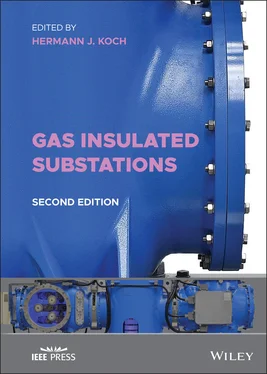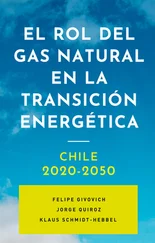Gas Insulated Substations
Здесь есть возможность читать онлайн «Gas Insulated Substations» — ознакомительный отрывок электронной книги совершенно бесплатно, а после прочтения отрывка купить полную версию. В некоторых случаях можно слушать аудио, скачать через торрент в формате fb2 и присутствует краткое содержание. Жанр: unrecognised, на английском языке. Описание произведения, (предисловие) а так же отзывы посетителей доступны на портале библиотеки ЛибКат.
- Название:Gas Insulated Substations
- Автор:
- Жанр:
- Год:неизвестен
- ISBN:нет данных
- Рейтинг книги:3 / 5. Голосов: 1
-
Избранное:Добавить в избранное
- Отзывы:
-
Ваша оценка:
- 60
- 1
- 2
- 3
- 4
- 5
Gas Insulated Substations: краткое содержание, описание и аннотация
Предлагаем к чтению аннотацию, описание, краткое содержание или предисловие (зависит от того, что написал сам автор книги «Gas Insulated Substations»). Если вы не нашли необходимую информацию о книге — напишите в комментариях, мы постараемся отыскать её.
Gas Insulated Substations (GIS)
Gas Insulated Substations — читать онлайн ознакомительный отрывок
Ниже представлен текст книги, разбитый по страницам. Система сохранения места последней прочитанной страницы, позволяет с удобством читать онлайн бесплатно книгу «Gas Insulated Substations», без необходимости каждый раз заново искать на чём Вы остановились. Поставьте закладку, и сможете в любой момент перейти на страницу, на которой закончили чтение.
Интервал:
Закладка:
Boston, November 2021
Foreword GE Grid Solutions
I started my career in GIS activity 24 years ago and at that time I wish I had such a book with me to speed‐up my comprehension and expertise on GIS. I must admit that after all these years, this book has found its place on my desk and is frequently opened to enrich my knowledge or to find a specific answer to questions that were never raised before.
GIS is gathering a wide field of technology and expertise within high‐voltage world, like switching components, measuring instruments, arresters, bushings, LV equipment, control and monitoring, structures, etc. Many documents, guides, and standards are needed to cover the full scope of GIS. CIGRE, IEC, and IEEE have been working hard for the last 50 years to gather knowledge and best practices for designing, manufacturing, installing, and operating GIS. For newcomers in GIS and even for experienced users, it is sometime difficult to find where is the information they are looking for. This book is just there to simplify their life. It is also the trusted door to access all necessary information they need as it has been written and reviewed by a wide panel of experts in GIS.
Since beginning of GIS in early 1960, technology has continuously changed and GIS got benefit of these changes. This revised edition is considering all recent breakthrough and coming trends in GIS like alternative gases, digital technology, and DC GIS.
I hope you will enjoy the reading and find the information you are looking for.
Arnaud Ficheux
CIGRE, IEC, and IEEE Member
GIS Technical Support and Innovation Manager, GE Grid Solutions
Aix‐les Bains, France, November 2021
Foreword Hitachi Energy
Gas‐insulated switchgear (GIS) operates invisibly, safely, and reliably and is often hidden in buildings or other structures. No movement can be seen, just a faint hum betrays the flow of bulk AC power. Perhaps that's why there has only been this one comprehensive reference work on GIS technology, further remarkable since it was only first published in 2014. The history of GIS dates back several decades, and its implementation has been very successful. GIS technology originated in 1936, when a Freon‐filled GIS assembly, rated at 33 kV, was demonstrated in the United States. Later, in the mid‐1950s, sulfur hexafluoride gas (SF6) was discovered, a gas with excellent insulating and arc‐extinguishing properties. By the mid‐1960s, GIS was sufficiently well developed to be commercially viable and appealing to a broader market. Today, GIS is an established technology that allows for safe, highly reliable operation in confined spaces, owing to its being enclosed and to its significantly reduced footprint compared to air‐insulated switchgear (AIS). This revolutionary technology was a key enabler for urbanization. Occupying only 10% of the volume required by the equivalent AIS, it allows flexible placement of substations within cities to supply safe and reliable power. Substations are no longer taking up acres of open spaces but can hide within buildings, underground, or on rooftops.
Although at first glance looking seemly uncomplicated, a closer examination reveals the engineering investment, the complexity in the variety of configurations, and the installation and testing effort found in a typical GIS installation. This handbook helps to decipher GIS technology, to present it in a clear and explanatory way, and gives a comprehensive overview of the subject, making it both interesting and indispensable for anyone with this technology. This includes those who want to start (or have already started) their career with manufacturers or end‐users of GIS. Descriptions of practical application examples, as well as operation and maintenance requirements, make the book equally interesting for switchgear operators and decision‐makers in energy policy. I also particularly recommend this book to students, as this book provides the most comprehensive overview of the technology currently available.
Today, our power transmission systems are subject to new requirements and far‐reaching changes, ushering in a new era of electrical grids and switchgear. On the one hand, an enormous flow of electricity to large megacities often has to cross several thousand kilometers, from the energy sources to the end‐user with transmission voltages of 1100–1200 kV having been established. Secondly, a large expansion of the transmission grid is required due to global plans for the extensive integration of new renewable energies into the electrical energy supply. Especially in the case of large‐scale (multi‐GW) offshore wind farms, the connection to the onshore grid will be made by means of HVDC. The increasing demand for HVDC technology requires the adaptation of gas‐insulated switchgear. Finally, the latest developments in the development and use of eco‐efficient GIS solutions and the integration of digital techniques in design and diagnostics are worthy of special mention. It combines a low‐carbon footprint, superior reliability, and low lifecycle costs in a flexible product layout. These topics are described in the new chapter of this second edition of the GIS Handbook , further increasing its interest for all those who want to get to know and follow current and new development trends.
Finally, I would like to add that I am proud to have been able to make a modest contribution to the work of this group of authors, who are well known and esteemed by myself and others in the field.
Uwe Riechert
Switchgear expert, Hitachi Energy Switzerland Ltd
Zurich, Switzerland, November 2021
Foreword Siemens Energy
Today, metal‐enclosed gas‐insulated switchgear (GIS) is indispensable for safe and reliable power grids. The long experience of more than 50 years of worldwide operation in all climatic zones, onshore and offshore installations, speak for an excellent. GIS is mainly used where space is at a premium or environmental conditions significantly impact the reliability of insulators.
This means above all in urban and coastal areas, where load and the importance of reliability is increasing worldwide. The compact size in combination with modular functions offers a high degree of design diversity, enabling not only outdoor but also more easily indoor and underground installation with the least environmental impact. GIS also stands for more safety; the accessible points of live system parts can be reduced to a minimum. If the connections are realized with gas‐insulated lines (GIL) or power cables and without overhead lines, this can even become possible altogether. Today, GIS are available for AC and increasingly also for DC applications.
The GIS success is therefore well‐founded; GIS are made to ensure the best possible balance between design, materials used, maintenance effort, and maintenance intervals.
The development continues, on the way to a carbon‐free economy, alternative gases to SF 6without greenhouse effect have become more and more important in recent years and will be one of the main innovation drivers for the future. Climate neutrality is only achievable with greenhouse and F‐gas‐free technologies enabling electrical power grids with zero emission.
In addition, digital technologies entering including artificial intelligence enabling even higher reliability and more effective operations management.
I hope you enjoy finding all the latest information on GIS in one book, and I am sure that the book will help you to find answers to specific technical aspects and details.
Dr. Mark Kuschel
CTO High Voltage Gas‐insulated Switchgear
Siemens Energy, Switchgear Factory Berlin, Germany, 2021
Acknowledgements
This second edition of Gas‐Insulated Substations (GIS) is created by power engineering experts from the IEEE Power & Energy Society Substations Committee. In Working Group K10 GIS Book of the K0 GIS Subcommittee, more than 50 experts have contributed to this book with their knowledge and own practical experiences. For more than two years, since 2019, and at four working group meetings the content has been presented and discussed by the contributors. Many ideas have been added to this second edition GIS book to create a practical guide. This book is designed to help with the daily work of engineers in the planning, design, and erection of high‐voltage substations above 52 kV using GIS. Focus is given on practical information to find the best, most reliable, and economic solution for substations in the power network.
Читать дальшеИнтервал:
Закладка:
Похожие книги на «Gas Insulated Substations»
Представляем Вашему вниманию похожие книги на «Gas Insulated Substations» списком для выбора. Мы отобрали схожую по названию и смыслу литературу в надежде предоставить читателям больше вариантов отыскать новые, интересные, ещё непрочитанные произведения.
Обсуждение, отзывы о книге «Gas Insulated Substations» и просто собственные мнения читателей. Оставьте ваши комментарии, напишите, что Вы думаете о произведении, его смысле или главных героях. Укажите что конкретно понравилось, а что нет, и почему Вы так считаете.












